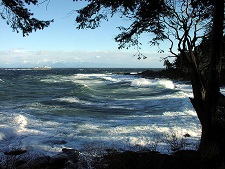Canada's top 10 weather stories for 2014: chapter 8
8. Powerful December Storms on West and East Coasts
During the second week of December, millions of Canadians from the West Coast, Central Canada and the Maritimes were bombarded by intense pre-winter storms featuring strong winds, drenching rains, flooding and heavy snowfalls. On the West Coast, a succession of three storms from tropical origins hammered Vancouver Island and mainland British Columbia’s central and south coasts with hardly a lull between them. Winds were fierce and rains heavy, but the air was warm. Relentless winds and rain punished the area - especially Vancouver Island’s higher westerly facing slopes. The combination of strong winds between 90 to 110 km/h and more than a month’s worth of soaking rains led to flash floods, pooling water on roads, washouts near rivers, and slides of mud and rock. Victoria got off lightly, but up-island the communities of Comox, Courtenay and Port Alberni were hit hard and continuously. Flooding in Courtenay following 250 mm of rain led to a local state of emergency. Some reservoirs were so full on Vancouver Island that they began spilling over. Heavy rains also closed local ski hills that had just opened. The weather led to cancelled ferry sailings on several routes, downed trees, power outages for thousands of homeowners and businesses, and flooded streets and basements everywhere. On B.C.’s lower mainland, the city of Delta also declared a brief state of emergency after winds and waves collapsed a beach wall. On the north shore of Vancouver, there were rain-triggered landslides and rock slides. The B.C. River Forecast Centre issued flood watches for four major rivers on Vancouver’s North Shore. Along Marine Drive in Vancouver, crews laid sandbags due to fears that king tides at the zenith of the winter season would inundate roads. And on the Sea to Sky Highway, some residents lost water after days of heavy rain damaged their local water source.

On the East Coast there was just one storm, but its incredible reach, intensity and slow movement produced widespread damages for residents in six provinces. The powerful nor’easter travelled up the Eastern Seaboard and stalled in the Gulf of Maine where, for three days, it sent out flooding rains, humongous snows and freezing rain driven by powerful winds and high seas. Rainfall amounts were staggering across all three Maritime provinces, measuring between 100 and 150 mm. Moncton got 142 mm of rain in one 24-hour period on December 10, far exceeding any other single daily rainfall in December since records began in 1881. The deluge of rain also smashed weather records in Grand Manan. Its storm rainfall over 48 hours was 162 mm. The system brought all forms of precipitation depending on the temperature but all were in large quantities. In New Brunswick and Prince Edward Island, any rainfall was a worry because the frozen ground left water having to run off instead of being absorbed. If the storm was stalled, so were residents in all three provinces who faced dangerous conditions out on the roads. At least three deaths were attributed to the storm that caused poor visibility, and washed out bridges and roads from the relentless wind-driven rains. People everywhere reported flooded basements and power outages. Authorities in New Brunswick issued flood warnings on the Nashwaak and Kennebecasis rivers. In the Acadian Peninsula, winds gusting up to 90 km/h blew in between 30 and 40 cm of snow that was then weighted down when the snows turned to rain.
The Cape Cod storm was so far-reaching that its last fling at North America was felt in western Quebec and southern and eastern Ontario. In those regions, winter’s first nasty storm was all about snow with between 20 and 30 cm being dumped. That, along with strong winds, caused the usual slow commute and hundreds of accidents.